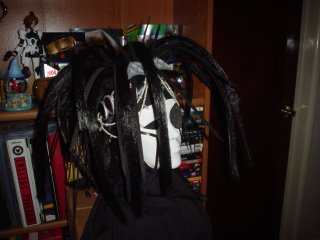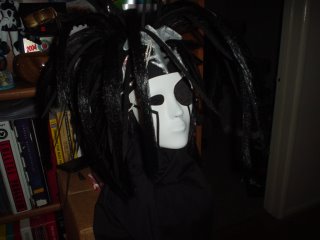I just thought that it would be fun to share what Im going through at the moment to improve on one of my all time favorite costumes. Im always of the feeling that I can always do better, so Im in the process of working on improving this costume. Throughout this blog, just click on the images you see to see a bigger version.
If you dont know who Darcia is or what he looks like in his costume:

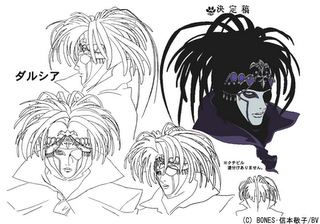
For this one, I am completely redoing the entire outfit, including his coat. Some of you remember me from Kawaii Kon 2005

I always felt that I didn't like the way my original wig turned out. It didn't have that "body" that is apparent in the anime or the images of him, so after fiddling around, I finally decided to do something about it.
In this post, I'll go through the process in which I am attempting to make the wig better, and later through the rest, I'll even describe how I am redoing the coat and the headdress he wears.
So first off, the wig.
This time, I decided to go with what I had originally done, cutting 1/4" strips of Stiffened Black Felt.
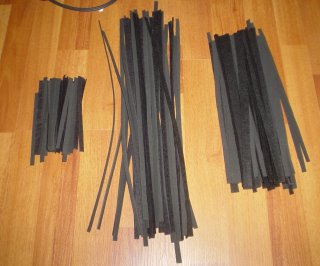
There are three sizes that I plan on working with. The full 14" length (that the stiffened felt comes in). The 9" length (which is the other way the stiffened felt was cut) and 1/3 of 14" pieces. The 14" and 9" lengths will all be wefted together with strips of extension hair. The smallest pieces will just be added to the wig to give it more texture and depth.
Also, I am using 22 guage Floral Wire, that I spray painted black:

Now with both felt and wire ready, I sewed the wire to the felt so it can give it strength:

Once done, I took wefts of extension hair and hot glued the tips to the wired felt:
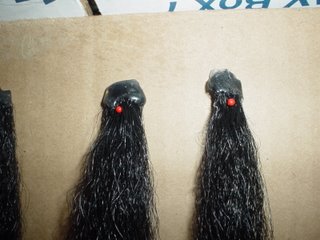
So, soon, I'll have a bunch of wefts stuck to a cardboard box in my kitchen:
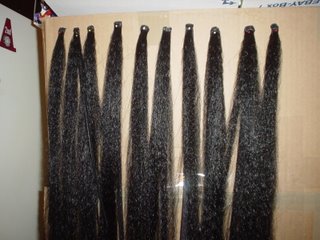
(make note, Dani, buy a lamp for your living room so you can do this there instead of the kitchen)
Once the wefts are ready, I took the Got2b Glued hairspray and began spraying and blowdrying the wefts so they would hold their shape and be stiffened:

I highly recommend this hair product for any type of spiking, wefting, or sticking hair to some other object. Its a miracle worker.
Now the wefts are ready, time to sew them into the wig:

Side view:

Once sewn in, you can see from the photos above that I already am attempting to give them the curved looked as referenced from his images above. I've only sewn in a few, but I am pinning the rest of the wefts into place so that I can guage to how much wefts I'll need to make, of which size and where the smaller strips of felt will go once the bulk of the hair is sewn in.
As it is now, its a work in progress, but keep visiting as I continue to add to this project.
Update: Well, after 24 hours of wefting, sewing, and hot-gluing and hair spraying, I've managed to finish this little recreation. Below are the images of the completed wig.


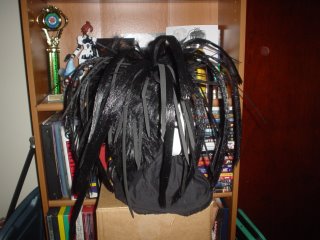
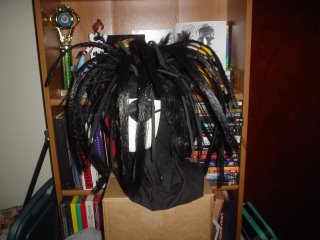
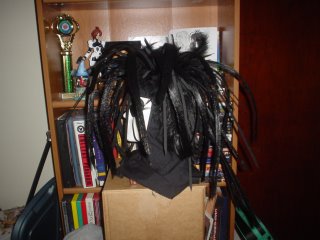
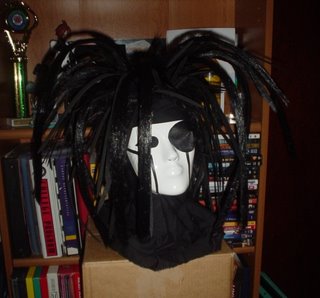
Update: I've edited this blog so that you can see how to cast the accessories in the Nov. 2nd post. Please view that post as to how to make your own accessories by using Hot Glue (Thermal Adhesives).
Update: After painting the castings for the headpiece, I assembled the accessory together. So here it is , Darcia's head....
